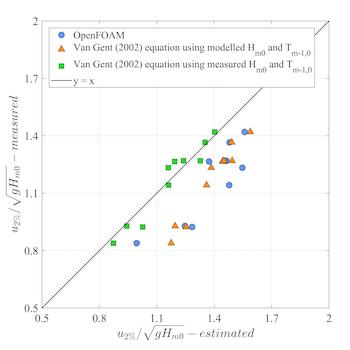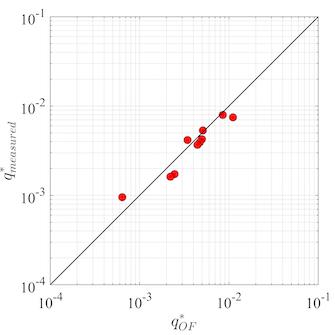W. Chen1,2*, J.J. Warmink 1, M.R.A. van Gent2, S.J.M.H. Hulscher1
1 University of Twente,
2 Deltares,
Introduction
The overtopping flow on the crest and landward slope can cause erosion at the landward side of dikes, which can finally lead to dike breaching. Extreme flow velocities, layer thickness and volumes, which have a low probability of exceedance during a storm event, are usually used to characterize the wave overtopping flow. Some empirical equations are available to estimate the flow velocity and layer thickness. However, these empirical equations were derived based on experiments where only limited wave conditions and dike configurations were tested. It remains unclear if these empirical equations are applicable for cases that are outside of the tested ranges. Numerical modelling has become an important complementary tool to experiments. The objectives of our study are to set up a numerical model using OpenFOAM® that is capable of accurately predicting the overtopping flow parameters and to investigate the effects of berms and roughness on flow parameters.
Methods
The waves2Foam toolbox was applied to generate irregular waves and the solver waveIsoFoam which is included in the waves2Foam was used to solve the model. The OpenFOAM model was validated by comparing the modelled overtopping discharges, flow velocities and layer thickness with the measured results from Van Gent (2002).
Results
Figure 1(a) shows the comparison between the modelled dimensionless average overtopping discharges with the measured ones with a NSE of 0.84. Figure 1(b) shows that the flow velocity predicted by the OpenFOAM model is slightly larger than the measured flow velocity. This overestimation is caused by the overestimation of the wave period given by the OpenFOAM model. Overall, the numerical model is capable of predicting the overtopping flow parameters with a good accuracy. The validated OpenFOAM model will be applied to investigate the effects of berms and roughness at the waterside edge of the crest on the overtopping flow parameters.


Figure: Model validation with (a) Measured versus modelled dimensionless mean overtopping rate and (b) Measured flow velocities and estimated ones using analytical equations and the OpenFOAM model.
Acknowledgements
The first author thanks the China Scholarship Council for providing the research grant. This work is also part of the All-Risk research programme, with project number P15-21, which is partly financed by the Netherlands Organisation for Scientific Research (NWO).
References
Van Gent, M. R. A. (2002). Low-exceedance wave overtopping events: Measurements of velocities and the thickness of water-layers on the crest and inner slope of dikes. Delft Cluster DC1-322-3.
I. Surname1*, F.N. Another-Surname2 , Y. Next-Surname2
1 University Name, Country; 2 Organization Name, Country
* Corresponding author: mail.name@organization.org


